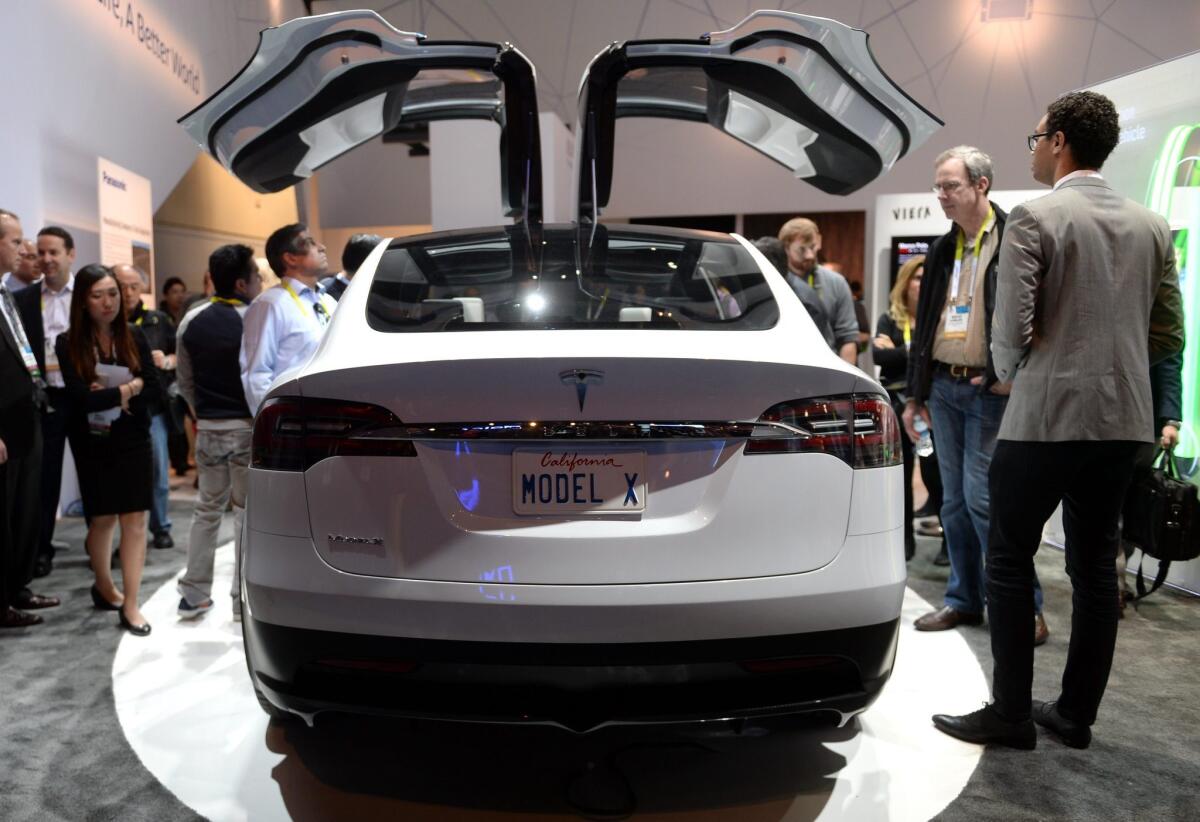Ramping up production of affordable Tesla may take years, Elon Musk says

- Share via
reporting from DETROIT — A day after General Motors Co. unveiled a prototype of an affordable, long-range electric vehicle by 2017, Tesla Motors Inc.’s chief executive, Elon Musk, said it could take until 2020 to put a comparable mass-market EV into full production.
Tesla could start selling its Model 3 by 2017, but Musk acknowledged that it could take years to develop the manufacturing capacity to fulfill demand. Tesla will need the higher-volume model to make the company profitable by 2020, Musk said at an automotive industry conference in Detroit.
Musk continued to lay out sky-high goals for the Palo Alto company, however, including sales of 500,000 by 2020 and “several million” by 2025. To reach that goal, Musk conceded, Tesla must double its annual production every year for many years running.
Last year, Tesla produced about 35,000 of its Model S electric sports sedan, which has an average sales price of about $100,000. The company plans to launch the similarly priced Model X compact utility vehicle this year and then a $35,000 Model 3 sedan.
Musk initially said the Model X would go on sale in early 2014, but has delayed the launch several times since then.
Tesla shares, which closed Tuesday at $204.25, up $2.04, or 1%, dropped 7% in after-hours trading on the news, and analysts began expressing doubt about Musk’s projections.
“This is Elon Musk’s M.O., from as far back as his first vehicle,” Kelley Blue Book senior analyst Karl Brauer said. “Whatever the numbers were — what it would cost, how far it would go, how fast it would go, and when it would be available — every one of those figures got revised on an ongoing basis, and always in the wrong direction.”
Musk conceded that he has over-promised in the past. “I do have an issue with punctuality,” he said. “I am too optimistic, and that leads me to thinking it can get done sooner than it can.”
That’s clear from Musk’s projections during the early days at the electric car company.
In a blog post from August 2006 — years before Tesla’s first car, the Roadster, hit the market — Musk wrote that more affordable models were on the way.
“I can say that the second model will be a sporty four door family car at roughly half the $89k price point of the Tesla Roadster, and the third model will be even more affordable,” he wrote.
In fact, the Roadster went on sale in 2008 for just under $100,000, and by 2010 the base price was $110,000. The second model was a sporty four-door family car, but it starts at more than $70,000 and can exceed $110,000 with options, including the battery with the longest driving range.
The Model X crossover is expected to be priced about the same as the S sedan when deliveries begin. Musk also said that fourth-quarter sales in China may have been soft, which caused concern among analysts.
“China is a huge market in the luxury segment, in a country with pollution issues,” Brauer said. “China should be huge for Tesla.”
Musk attributed the slow sales to a “misperception” by Chinese consumers concerning whether they would be able to charge electric cars in large housing complexes. He said Tesla is working to clear up the issue and expects sales to rebound.
Analysts worried more about the possibility of delays in delivering the planned Model 3, which Musk said could sell for less than $30,000 once government incentives are figured in. The federal government offers a $7,500 tax credit to buyers of electric cars; California offers buyers an additional rebate of $2,500.
Detroit giant General Motors said its new Bolt could be sold at a similar price — with a range of 200 miles between charges — and would be in production by 2017.
The Tesla Model S has a range of either 208 or 265 miles, depending on the battery option selected.
Timely delivery of the Model 3 is crucial to Tesla’s success — and for returns to shareholders, who have seen Tesla’s stock rise from $30 a share to a high of $279 in less than three years.
“The third model is the make-it-or-break-it product for Tesla,” Gartner analyst Thilo Koslowski said. “They have a real success in the Model S and the Roadster. But in order to get to a mainstream product, they have to make the third model really right — in terms of range, quality and price point.”
As Tesla sales volume grows, it will have to start manufacturing cars close to the regions where it sells them. To date, the vehicle has done best in the U.S., Western Europe and China.
“We don’t want to put cars on ships,” Musk said.
He said he anticipates building three additional factories in Asia, Europe and the eastern half of the U.S.
Musk also reiterated his enthusiasm for electric car competition from other automakers, and praised GM Chief Executive Mary Barra for greenlighting that automaker’s Bolt electric car program.
He characterized his company’s role as “cutting a path through the jungle to show what can be done with electric cars,” and said he doesn’t see GM’s plans as a competitive threat.
“There’s 100 million new cars and trucks made a year,” he said. “What does it matter if a few thousand more are electric?”
Hirsch reported from Detroit and Fleming from Los Angeles.
Times staff writer David Undercoffler contributed to this report.
Jerry.hirsch@latimes.com
Charles.fleming@latimes.com








